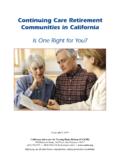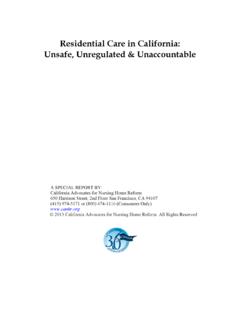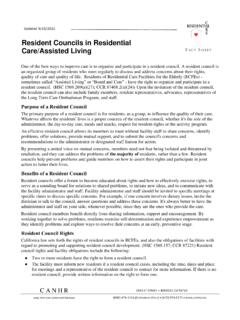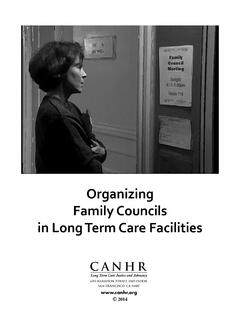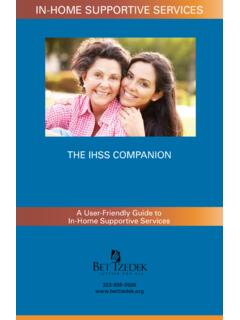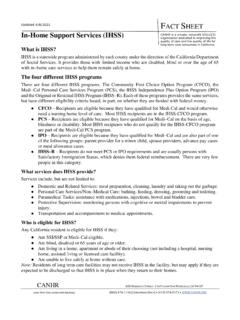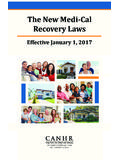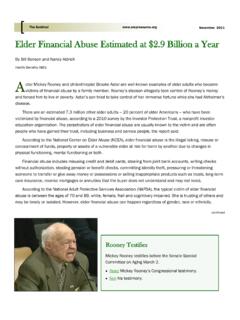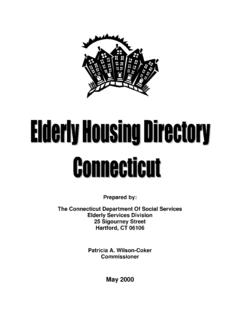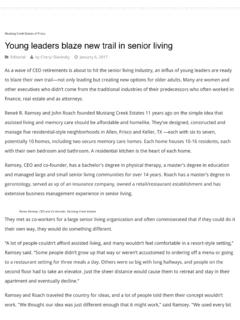Transcription of Visitation Guide for California Long Term Care …
1 California Advocates for Nursing Home Reform650 Harrison Street, 2nd Floor San Francisco, CA 94107 (800) 474-1116 (Consumers only) (415) 974-5171 2015 California Advocates for Nursing Home Reform. All Rights ReservedVisitation Guide for California long Term care Facilities and Hospitals 2 Visitation Guide for California long -term care Facilities and Hospitals While this Guide is written to help nursing home residents protect themselves, it is not intended to provide legal advice or to substitute for a consultation with an attorney. This Guide is for informational purposes only. If you or a loved one is living in a nursing home and has been the victim of a rights violation, please call CANHR at (800) 474-1116 for more information.
2 Copyright 2015, updated August 2015 California Advocates for Nursing Home Reform (CANHR)650 Harrison Street, 2nd Floor, San Francisco 94107(800) 474-1116 (Consumers only) (415) 974-5171 , and all other forms of reproduction, without permission is prohibited. 1 Chapter I. Visitation Rights In California Health And long Term care FacilitiesThe right to visit with people is among our most sacred personal Even the Constitution guarantees a right to visit by preventing the federal or state governments from abridging our freedom to associate. Visitors to hospitals and long -term care facilities often defer to the institution s rules about visi-tation, legal or not, because they seem to have implicit authority to make their own rules.
3 However, such deference lacks the perspective that these institutions are also often the homes of the residents. Visitation rules are only enforceable if they honor the basic rights of the is extremely important to hospital patients and residents of long -term care facilities. Studies show Visitation is highly correlated with improved quality of life for patients and residents. Regular visits prevent residents from feeling depressed and isolated and often enhance their initiative to rehabilitate ag-gressively to return home sooner. In addition, regular Visitation tends to improve the quality and level of care the resident receives. Facilities tend to give more staff time to residents who have regular visitors to observe whether the care being provided is sufficient. Visitors can serve as advocates for residents who receive poor A.
4 Skilled Nursing FacilitiesA skilled nursing facility, commonly known as a nursing home, is a facility where residents stay for extended periods of time2, from a few weeks to several years. Residents of nursing homes live there be-cause they can no longer perform one or more crucial life functions without assistance, such as walking, using the restroom, eating, and so on. Often, the focus of the residents stay is to receive rehabilitation and therapy to improve their independence so they can go home. In a skilled nursing facility, nurses and other staff must be present twenty-four hours a day to provide care to , residents of skilled nursing facilities have the right to receive visitors and family members have their own right to visit with Family members of the resident may visit any time.
5 They are not bound by a facility s Visitation hours long -term care ombudsman, the resident s physician, the resident s attorney, and clergy members may also visit the resident any Other visitors, includ-ing friends, neighbors, etc., may visit during the facility s visiting hours. The visiting hours restriction on non-family members does not usually apply if the resident is critically have a right to private visits, which means they can seek a private meeting space in which to 1 See California Assembly Bill 1085 (Gatto, 2015): The Legislature finds and declares that every adult in this state has the right to visit with, and receive mail and telephone or electronic communication from, whomever he or she so chooses, unless a court has specifically ordered otherwise. 2 Cal. Health & Safety Code 1250(c)3 42 1395i-3(c)(3)(B), 42 1396r(c)(3)(B); Cal.
6 Health & Safety Code 22 CCR 72527(a)(17)5 42 CFR (j)(1)6 22 CCR 72527(a)(19)The Centers for Medicare and Medicaid Services (CMS) have guidelines about residents rights in long -term care facilities. CMS explains that the resident has a right to visit and be visited by others outside the facility. This means that, in addition to receiving visitors at the facility, residents have the right to leave the facility temporarily to see their visitors. Thus, residents have the right to go out to lunch or dinner or some other event with their family and friends. 2have their Residents also have the right to use telephones for making and receiving confidential calls and to send and receive unopened While these rights are not directly related to in-person visi-tation, having the right to private communication allows a resident or visitor to arrange for such visits.
7 Private communication also allows family members to check with the residents themselves whether they want visitors. If a facility hampers a resident s private communications, the resident s Visitation rights are B. Residential care Facilities for the ElderlyA residential care facility for the elderly ( RCFE ) is a type of living arrangement for people 60 years of age or over who need some help with daily living that does not rise to the level of care required by nurs-ing home residents. RCFEs are usually considerably less institutional, many of them located in single family in nursing homes, residents of RCFEs (commonly known as assisted living facilities ) have the right to visit privately with anyone of their choosing in the facility, including family, friends, Ombudsman, and advocates, for meetings without prior These visits are limited to reasonable hours of the The facility must inform residents of its Visitation hours when they are RCFE residents are not limited to having visitors in the facility.
8 They can see their friends and family off-site because they have the right to leave the facility at any time. Residents cannot be locked into any room, building, or in any part of the facility unless they or a court-appointed conservator have consented. However, the facility may still establish house rules for resident safety, including the locking of doors at night and the barring of Residents have a right to make and receive confidential telephone calls and to receive and send unopened mail Residents also have a right to prompt answers to their family members communications with the Though these rights do not have a direct relationship with Visitation , residents rights to private and effective communication with the facility and family members allows Visitation to be ar-ranged. For instance, a resident without proper access to telephone and mail might not be able to arrange for visits in advance.
9 7 (j), State Operations Manual, Appendix PP8 42 CFR (k); 42 CFR (j)9 Cal. Health & Safety Code (a)(24)10 22 CCR 87468(a)(11)11 22 CCR 87468(a)(10), Cal. Health & Safety Code 22 CCR 87468(a)(6)13 22 CCR 87468(a)(14); 22 CCR 87468(a)(15)14 22 CCR 87468(a)(10)The long -term care Ombudsman is a free advocacy service for residents of long -term care facili-ties. Each county has an Ombudsman program. A list of the Ombudsman programs for each county is included in the Appendix. The programs are dedicated to advocating for long -term care residents regarding multiple issues, including their right to Visitation . Ombudsman can help with Visitation by 1) informing the facility about Visitation rights and 2) accompanying a visitor during a visit to ensure the resident s rights are respected.
10 3 Section C. continuing care retirement CommunitiesA continuing care retirement community ( CCRC ) represents the range of assisted living available to residents, from independent living to skilled nursing facilities. The services are offered by a single entity operating on a single campus. A resident may enter a CCRC living independently and requiring minimal assistance but may progress to more extensive levels of care within the community as he or she ages. CCRCs are usually characterized by expensive entrance fees in exchange for care services for the remain-der of the residents general, residents of CCRCs have the right to live in an environment that maintains their independence, as well as their ties to the local Since a CCRC is a system of different levels of care based on the resident s needs, ranging from independent living to skilled nursing, Visitation rights at a CCRC will depend largely on what level of care the resident is instance, the laws regarding Visitation for RCFEs govern Visitation at the assisted living level of care in a retirement community.
